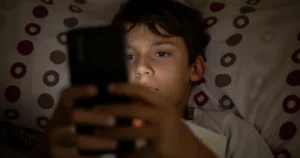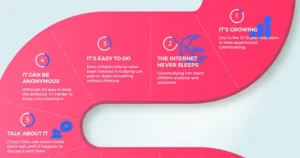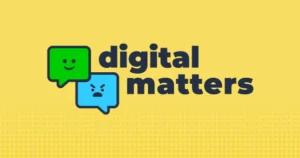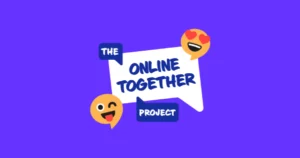What is cyberbullying?
Guide to online bullying for parents
Unlike bullying offline, cyberbullying can follow a victim wherever they go through social media networks, gaming platforms and over messaging.
 Close video
Close video
Quick tips
4 things you need to know about cyberbullying
Cyberbullying can happen via text, email and on social networks and gaming platforms. It can consist of:
- Threats and intimidation
- Harassment and stalking
- Defamation
- Rejection and exclusion
- Identify theft, hacking into social media accounts and impersonation
- Publicly posting or sending on personal information about another person
- Manipulation
According to UNICEF, cyberbullying can dramatically impact the mental health of young people. The effects can last a long time and affect a young person in many ways.
Cyberbullying is bullying that takes place over the internet. This can be across social networks or through direct messages.
Ofcom’s children and parents media use report shows that 84% of 8-17s say they have been bullied on social media, through text message and on other online platforms, compared to 61% face-to-face.
- Learn about cyberbullying
- Cyberbullying facts and statistics
- What are the signs my child might be experiencing cyberbullying?
- Resources to learn about more cyberbullying
- Featured cyberbullying articles
Learn about cyberbullying
Cyberbullying is the repetitive and intentional hurting of a person or group of people that happens online. Learn more about the issue below.
How does cyberbullying differ to face-to-face bullying?
One of the biggest differences between cyberbullying and face-to-face bullying is that cyberbullying is often hard to get away from. Young people can be bullied anywhere, anytime – even when they’re at home. Additionally:
- It can reach a vast audience in a matter of seconds
- ‘Repetition’ is taken to a different level, with bullies sharing hurtful comments and images multiple times
- Cyberbullying can impact children at any time of day or night
- It can offer a degree of anonymity to the perpetrator
- It’s difficult to police and to punish
- There is often some form of evidence (e.g. screenshot, text message)
What impact can cyberbullying have on a child?
Cyberbullying can have a huge impact on a young person and it can affect them in different ways, including:
- Mentally – feeling upset, embarrassed, stupid, even afraid or angry
- Emotionally – feeling ashamed or losing interest in the things they love
- Physically – tired (loss of sleep), or experiencing symptoms like stomach aches and headaches
As well as this, it can spark feelings of fear for young people. Our 2023 survey found that 77% of children that experienced online abuse found it ‘scary’.
Child Trauma Psychotherapist Catherine Knibbs also highlights the feelings a child might experience or behaviour they might show as a cyberbully:
Embarrassment is about looking like a ‘fool’ to others but having the resilience to ‘laugh it off’. Neuroscientifically, it’s something you can recover from pretty quickly.
In your child, you might notice their embarrassment by the shyness they show when trying to discuss cyberbullying. They might say ‘you’ll laugh at me’ or something similar. However, there’s still that willingness to talk about it.
How to support your child
You can help your child by explaining that sometimes we feel silly, but that feeling will pass. If we’ve done something silly (like name-calling to join in with others/peers), realising our mistake and apologising can help repair relationships.
You can ‘normalise’ this behaviour if it is accidental and not intended to be vicious. Think about how we laugh at some TV programmes that show silly human behaviour. However, it’s important to highlight that intentional hurtful behaviour is very different.
Guilt is a feeling that a cyberbully is more likely to carry as they recognise they ‘did something bad’.
Quite often. children will stay quiet and secretive, avoiding you. They might say things like ‘you’ll ground me’, ‘you’ll get mad’, ‘you’ll take away my phone’ or similar words, because they expect that you will punish them for the act of doing something bad.
How to support your child
We can help our children here by explaining that they made a bad choice, that the choice has consequences and that the choice they made has affected another person. This allows for a resilient feeling of being able to ‘make up for the bad choice’, which in brain terms is a healthy response to building a more compassionate child for the future.
Quite often in my therapy room, I ask parents not to reflect too much on the aspect of ‘pointing out the victims’ feelings too much’ as this adds to the feeling of both guilt and shame.
Both victim and cyberbully can encounter shame, which often displays as ‘I am bad’. This is usually easier to spot by behaviours and words that reflect a lack of self-esteem or self-worth. Children experiencing feelings of shame might say things like ‘nobody likes me’, ‘I’m no good’ and ‘you’ll hate me’. These children are suffering both emotionally and physically.
In a state of shame, the body begins to produce chemicals that are not helpful for brain development, empathy and compassion. The child begins to withdraw inwards or act outwardly, such as through aggression.
How to support your child
We can help our children here, not by over-praising them, but by connecting with them. Reflecting to them that we know what shame feels like (most of us do!) and how difficult it is can help them feel less alone. This can also reduce the likelihood that they will act out in those aggressive or otherwise harmful ways.
Cyberbullying facts and statistics
According to Ofcom, 84% of 8-17s say they have been bullied on social media, through text message and on other online platforms, compared to 61% face-to-face.
70% of parents worry about online trolling or abuse from strangers, and 66% are concerned about their child being harassed by other children online.
Our research shows that 71% of parents worry about their child experiencing online bullying by someone they know.
Despite issues faced online, 55% of children aged 9-16 say that using the internet has a positive impact on their wellbeing.
What are the signs my child might be experiencing cyberbullying?
Your child might be reluctant to tell you that they are worried about cyberbullying. So it’s important to look out for the signs. These could include:
- Ignoring electronic devices suddenly or unexpectedly
- Any changes in general behaviour such as becoming withdrawn, angry or lashing out
- Nerves around their devices
Other signs include a reluctance to go to school or take part in usual social activities, unexplained stomach upsets and avoidance when talking about the internet.
The difference between cyberbullying and abuse
Some extreme forms of cyberbullying go beyond bullying. Child-on-child abuse, ‘sextortion’ (also known as child sexual exploitation) and harassment have elements of bullying, but they can cause more harm. While there are no laws that prevent cyberbullying.
Child-on-child abuse is abusive behaviour that ranges from sexting to grooming between those under 18.
Online hate is language or actions that target a characteristic of a person or group of people in the digital space.
Child sexual exploitation is sometimes called ‘sextortion’. It refers to extorting sexual images from children.
Cyberbullying terms and definitions
Online bullying can take many shapes but not all forms are easy to understand. Explore the different types of cyberbullying and bullying behaviours by selecting a word below.
To intentionally make a person angry by saying or doing things to annoy them.
Stealing someone’s profile or setting up fake profiles to lure people into starting online relationships.
Sending repeated and frequent messages that include real threats of physical harm.
Sending or posting information that’s intended to damage someone’s reputation.
Deliberately excluding someone from online conversations, games and activities.
Sending angry and abusive online messages to intentionally provoke someone into starting an argument.
Logging into someone else’s account, impersonating them or posting inappropriate content in their name.
Abusing and angering people through online gaming.
Targeting an individual or group with persistent and offensive messages which could develop into cyberstalking.
Publicly sharing personal, private or embarrassing information, photos or videos about someone online.
Ganging up on an individual online and sending offensive abuse until the victim is seen to ‘crack’.
Deliberately posting provocative and insulting messages about sensitive subjects or inflicting racism or misogyny on an individual.
Cyberbullying resources to support children
Use the following resources to teach children about cyberbullying to help the recognise
when it happens.
Featured cyberbullying articles
 Q&A
Q&A
What can parents learn from the ‘Adolescence’ series on Netflix?
Experts share tips to help parents navigate discussions about 'Adolescence' on Netflix.
 Expert opinion
Expert opinion
What tech-facilitated abuse looks like in teenage relationships
Lauren Seager-Smith from The For Baby's Sake Trust explores what tech-facilitated abuse looks like in relationships and how to keep teens safe.
 News & blogs
News & blogs
What is undress AI? Guidance for parents and carers
Artificial intelligence continues to increase in ability and technology. Undress AI is one example that could leave young people open to harm.
 Expert opinion
Expert opinion
It takes a village: How male role models can challenge online misogyny
Learn about how male role models can impact young boys' views of girls with guidance from The NWG Network.
 Expert opinion
Expert opinion
How to counter online hate and extremism with young people
Hate and Extremism Analyst, Hannah Rose, shares insight into how young people might get involved online. Learn how to counter online hate.



